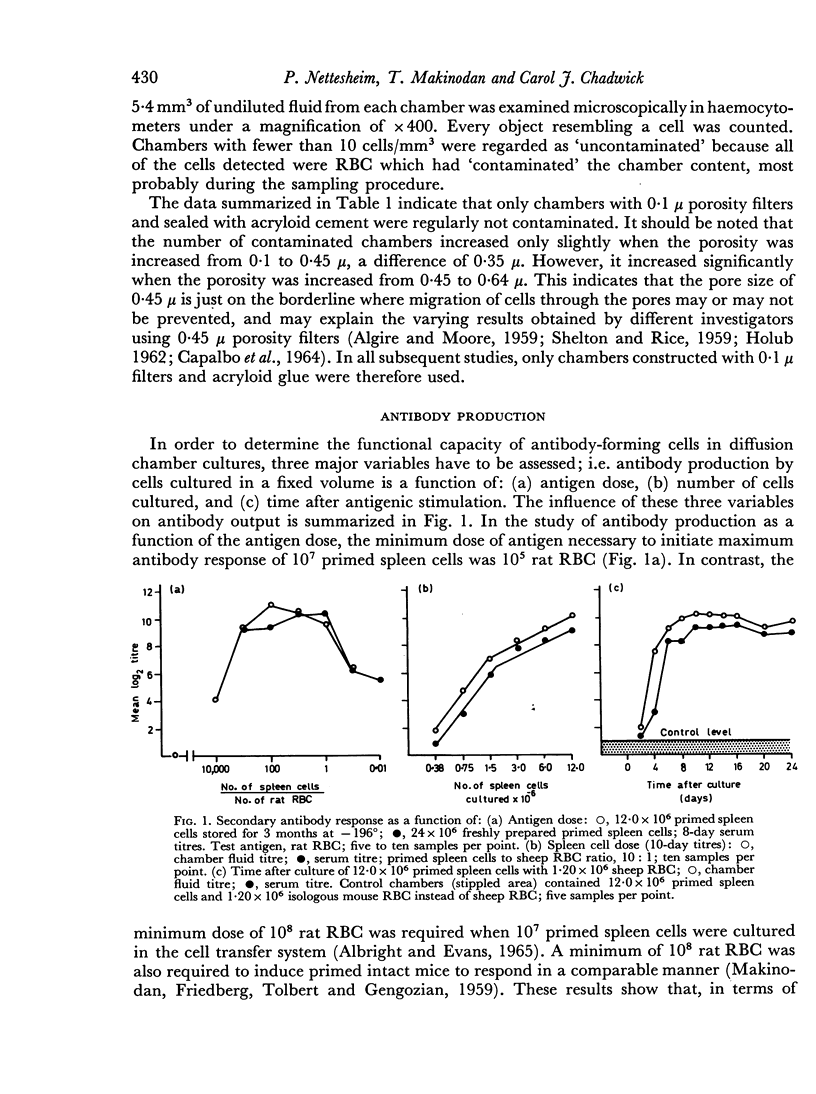Abstract
Diffusion chambers (3×10 mm) constructed with 0.1 μ porosity filters, but not with 0.45 μ or greater porosity filters, were found to be consistently cell impermeable, with use of acryloid as the glueing agent. The filters permit free diffusion of 19S and 7S antibodies into `empty' chambers in vivo and in vitro. Pronase treatment of the chamber dissolves the clot and frees cells attached to the inner surfaces. This permits almost complete recovery of the chamber culture cells.
Chamber cultures can be readily transferred from one host to another and kept in vitro at room temperature for at least 6 hours without any loss of activity. In vivo diffusion problems arise after 1 month of culture, most probably due to excessive growth of peritoneal cells on the outer surface of the filters; this limitation can be overcome by serial in vivo transfer of the chamber and wiping the outer surface at the time of transfer.
The diffusion chamber culture method as described here fulfills all the prerequisites of an assay system with which one can perform precise cytokinetic analysis of antibody response.
Full text
PDF












Images in this article
Selected References
These references are in PubMed. This may not be the complete list of references from this article.
- ALGIRE G. H., WEAVER J. M., PREHN R. T. Growth of cells in vivo in diffusion chambers. I. Survival of homografts in immunized mice. J Natl Cancer Inst. 1954 Dec;15(3):493–507. [PubMed] [Google Scholar]
- Albright J. F., Evans T. W. Influence of antigen dosage on kinetics of hemagglutinating antibody production. J Immunol. 1965 Aug;95(2):368–377. [PubMed] [Google Scholar]
- BERMAN I., KAPLAN H. S. The cultivation of mouse bone marrow in vivo. Blood. 1959 Sep;14:1040–1046. [PubMed] [Google Scholar]
- BRYSON D. L. DEVELOPMENT OF MOUSE EGGS IN DIFFUSION CHAMBERS. Science. 1964 Jun 12;144(3624):1351–1353. doi: 10.1126/science.144.3624.1351. [DOI] [PubMed] [Google Scholar]
- CAPALBO E. E., ALBRIGHT J. F., BENNETT W. E. EVALUATION OF THE DIFFUSION CHAMBER CULTURE TECHNIQUE FOR STUDY OF THE MORPHOLOGICAL AND FUNCTIONAL CHARACTERISTICS OF LYMPHOID CELLS DURING ANTIBODY PRODUCTION. J Immunol. 1964 Feb;92:243–251. [PubMed] [Google Scholar]
- CASTELLANOS H., STURGIS S. H. Ovarian homografts: survival within millipore filter chambers in the monkey. Obstet Gynecol. 1958 Dec;12(6):603–609. [PubMed] [Google Scholar]
- CURRAN R. C., ROWSELL E. V. The application of the diffusion-chamber technique to the study of silicosis. J Pathol Bacteriol. 1958 Oct;76(2):561–568. doi: 10.1002/path.1700760225. [DOI] [PubMed] [Google Scholar]
- GWATKIN R. B., THOMSON J. L. A NEW METHOD FOR DISPERSING THE CELLS OF MAMMALIAN TISSUES. Nature. 1964 Mar 21;201:1242–1243. doi: 10.1038/2011242b0. [DOI] [PubMed] [Google Scholar]
- HOLUB M. Potentialities of the small lymphocyte as revealed by homotransplantation and autotransplantation expriments in diffusion chambers. Ann N Y Acad Sci. 1962 Oct 24;99:477–486. doi: 10.1111/j.1749-6632.1962.tb45329.x. [DOI] [PubMed] [Google Scholar]
- Law L. W., Dunn T. B., Trainin N., Levey R. H. Studies of thymic function. Wistar Inst Symp Monogr. 1964 Aug;2:105–120. [PubMed] [Google Scholar]
- MAKINODAN T., FRIEDBERG B. H., TOLBERT M. G., GENGOZIAN N. Relation of secondary antigen injection to time of irradiation on antibody production in mice. J Immunol. 1959 Aug;83:184–188. [PubMed] [Google Scholar]
- Makinodan T., Albright J. F., Perkins E. H., Nettesheim P. Suppression of immunologic responses. Med Clin North Am. 1965 Nov;49(6):1569–1596. doi: 10.1016/s0025-7125(16)33247-3. [DOI] [PubMed] [Google Scholar]
- Makinodan T., Hoppe I., Sado T., Capalbo E. E., Leonard M. R. The suppressive effect of supraoptimum doses of antigen on the secondary antibody-forming response of spleen cells cultured in cell-impermeable diffusion chambers. J Immunol. 1965 Sep;95(3):466–479. [PubMed] [Google Scholar]
- SHELTON E., RICE M. E. Growth of normal peritoneal cells in diffusion chambers: a study in cell modulation. Am J Anat. 1959 Nov;105:281–341. doi: 10.1002/aja.1001050302. [DOI] [PubMed] [Google Scholar]
- SHELTON E., RICH M. E. Studies on mouse lymphomas. II. Behavior of three lymphomas in diffusion chambers in relation to their invasive capacity in the host. J Natl Cancer Inst. 1958 Jul;21(1):137–161. [PubMed] [Google Scholar]
- URSO P., MAKINODAN T. THE ROLES OF CELLULAR DIVISION AND MATURATION IN THE FORMATION OF PRECIPITATING ANTIBODY. J Immunol. 1963 Jun;90:897–907. [PubMed] [Google Scholar]
- VAZQUEZ J. J. Antibody- or gamma globulin--forming cells, as observed by the fluorescent antibody technic. Lab Invest. 1961 Nov-Dec;10:1110–1125. [PubMed] [Google Scholar]
- WILSON B. W., LAU T. L. DISSOCIATION AND CULTIVATION OF CHICK EMBRYO CELLS WITH AN ACTINOMYCETE PROTEASE. Proc Soc Exp Biol Med. 1963 Dec;114:649–651. doi: 10.3181/00379727-114-28758. [DOI] [PubMed] [Google Scholar]



